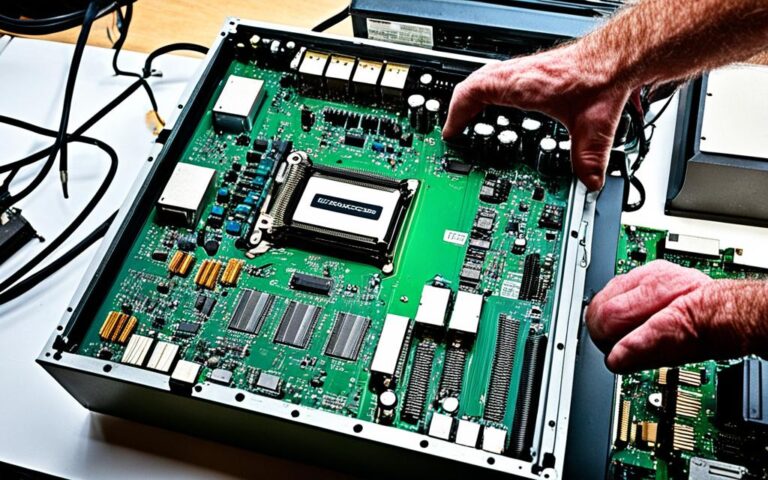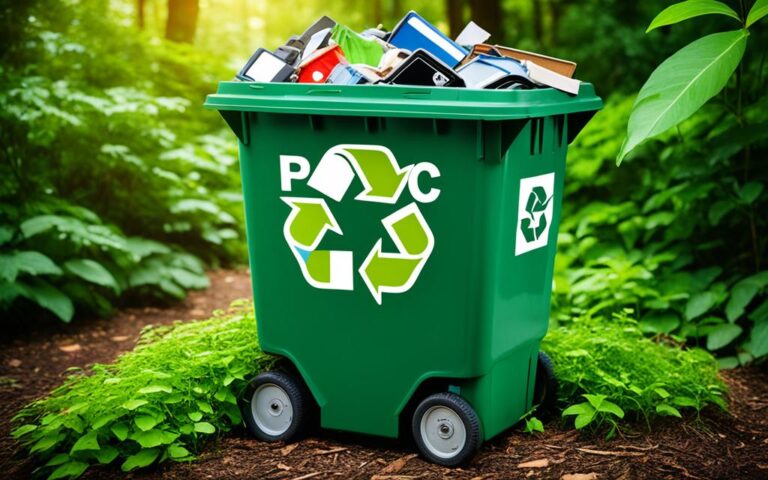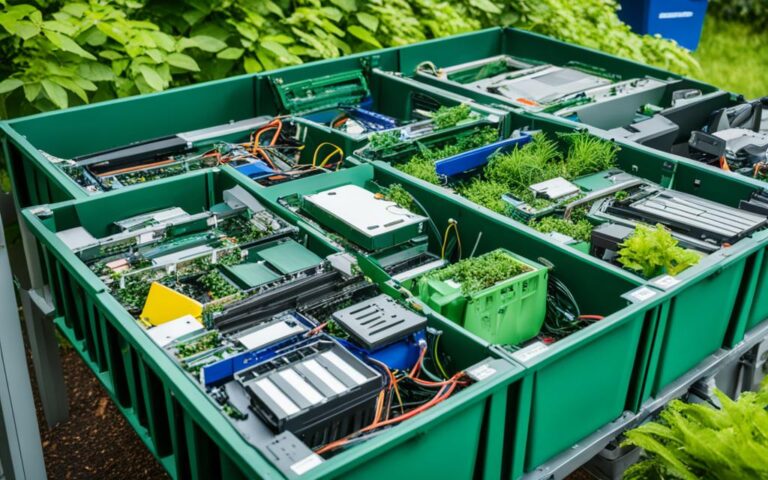Minimizing Waste: The Drive Towards PC Waste Reduction
In today’s business world, reducing the environmental impact of IT equipment has become a priority for companies seeking to optimize resource usage and minimize waste. By adopting strategies that extend the lifespan of IT assets and implementing proper disposal methods, businesses can achieve PC waste minimization. In this article, we will explore various tips and strategies to help businesses maximize efficiency and minimize waste in their IT operations.
As the demand for sustainable computing practices grows in the UK tech landscape, businesses are recognizing the importance of eco-friendly practices in their operations. Sustainable computing not only benefits the environment but also contributes to cost savings and improved corporate social responsibility.
Stay tuned for more information on how companies can reduce PC waste, promote sustainable computing, and make a positive impact on the UK tech landscape.
Cascading Older High-Performance Machines
One effective strategy for sustainable IT management is cascading older high-performance machines to different departments within the organization. This involves repurposing older machines for less demanding tasks or reallocating them to departments where there is a lower demand for high-performance specifications. By strategically reallocating machines based on their remaining capabilities, businesses can extend the useful life of their IT assets and minimize the need for premature replacements. This approach not only saves costs but also reduces electronic waste.
Benefits of Cascading Machines
Cascading machines offers several benefits to organizations:
- Optimized resource usage: By repurposing older machines, businesses can make the most out of their existing IT assets, minimizing the need for new purchases and reducing unnecessary waste.
- Cost savings: Repurposing older machines for less demanding tasks eliminates the need to invest in new equipment, resulting in significant cost savings for the organization.
- Reduced electronic waste: By extending the lifespan of IT assets, organizations can reduce the amount of electronic waste generated, contributing to a more sustainable IT environment.
- Sustainable IT management: Adopting cascading practices aligns with sustainable IT management principles, promoting resource efficiency and responsible consumption of technology.
By implementing a cascading strategy, businesses can reap the benefits of sustainable IT management while reducing their environmental impact. Let’s take a look at an example of how cascading machines can be effectively utilized within an organization.
“At XYZ Corporation, we have successfully implemented a cascading strategy for our high-performance machines. We identified departments that require less demanding tasks and reallocated our older machines to those areas. Not only did this approach optimize resource usage, but it also allowed us to extend the lifespan of our IT assets. This has resulted in significant cost savings for our organization while contributing to our sustainability goals.”
A Case Study: Cascading Machines at XYZ Corporation
| Department | Old Machine (Specifications) | New Use |
|---|---|---|
| Marketing | PC A (Intel Core i7, 16GB RAM, 512GB SSD) | Design tasks, video editing |
| Human Resources | PC B (Intel Core i5, 8GB RAM, 256GB SSD) | Data entry, document processing |
| Finance | PC C (Intel Core i7, 16GB RAM, 512GB SSD) | Accounting software, financial analysis |
By cascading older high-performance machines to different departments, XYZ Corporation was able to maximize the utilization of their IT assets. The repurposed machines were still capable of handling the specific tasks required in each department, ensuring efficient operations while reducing unnecessary hardware purchases. This approach not only extended the lifespan of their IT assets but also supported their sustainability initiatives by minimizing electronic waste and associated environmental impacts.
Laser Printers for Cost-Effective Printing
Investing in high-quality laser printers can be a sustainable solution for businesses that rely on printing. Laser printers require less maintenance, are more durable and reliable than inkjet printers, and offer energy efficiency advantages. The efficiency of toner usage in laser printers is higher than ink efficiency in inkjet printers, resulting in longer-lasting toner cartridges and a smaller environmental footprint. By opting for laser printers, businesses can achieve cost-effective and eco-friendly printing solutions.
When it comes to sustainability, laser printers have several advantages over inkjet printers. Laser printers use toner instead of liquid ink, which means they do not have ink cartridges that require frequent replacement. Toner cartridges in laser printers can last much longer than ink cartridges, resulting in reduced waste and cost savings for businesses. The energy efficiency of laser printers is also noteworthy, as they consume less power compared to inkjet printers.
“Laser printers offer businesses a more sustainable printing solution. By reducing the use of ink cartridges and consuming less energy, they contribute to sustainability and energy efficiency.”
In addition to their environmental benefits, laser printers also provide superior printing quality and speed. They are capable of producing sharp and precise prints, making them suitable for professional and high-quality printouts. Laser printers can handle large print volumes quickly and efficiently, saving time in busy office environments. Their durability and reliability ensure consistent performance over an extended period, reducing the need for frequent repairs or replacements.
Cost savings and long-term benefits
While laser printers may have a higher upfront cost compared to inkjet printers, they offer significant long-term cost savings. The longer lifespan of toner cartridges and lower maintenance requirements result in reduced printing costs over time. Businesses that rely heavily on printing can benefit from the durability and efficiency of laser printers, ultimately saving money in the long run.
Fewer printer replacements also mean less electronic waste. By investing in laser printers’ longevity and durability, businesses contribute to sustainability and reduce their environmental impact. Laser printers align with the principles of sustainable printing and can be an essential component of any business’s eco-friendly practices.
Ensuring Certified Disposal
Proper disposal of outdated IT equipment is crucial to prevent data breaches and environmental harm. Businesses should partner with certified e-waste recycling facilities that provide a certificate of destruction to ensure secure data erasure and compliance with privacy standards.
When choosing an e-waste disposal company, it’s essential to consider their certifications, compliance with environmental regulations, and membership in relevant industry associations. Certifications such as Waste Electrical and Electronic Equipment (WEEE) Regulations Compliance, ISO 14001, Environmental Agency Waste Carrier Registration, Recycling Association Membership, and Approved Authorised Treatment Facility (AATF) Status indicate a company’s commitment to responsible e-waste management.
Proper disposal is not only important for data security but also for meeting Environmental Agency Waste Carrier Registration standards. By partnering with certified e-waste recycling facilities, businesses can ensure that their outdated IT equipment is handled in an environmentally responsible manner.
By prioritizing certified disposal, businesses can contribute to a more sustainable IT landscape while protecting sensitive data and complying with regulatory standards.
Refurbishing for Bulk Buyback
One effective way to contribute to the circular economy and reduce electronic waste is by refurbishing old IT equipment for bulk buyback. Several companies specialize in this practice, offering businesses an opportunity to recover some of their investment while extending the useful life of their IT assets.
Refurbished equipment that meets certain performance standards can be resold, providing an alternative to new manufacturing and reducing the demand for additional resources. This approach not only helps minimize electronic waste but also allows businesses to recoup a portion of their initial investment in IT assets.
By participating in bulk buyback programs and opting for refurbished equipment, companies can actively contribute to a more sustainable IT landscape while minimizing their environmental impact.
The Benefits of Refurbishing IT Equipment
Refurbishing old IT equipment offers various benefits for businesses:
- Cost Savings: Refurbished equipment is often available at a lower cost compared to purchasing new devices, allowing businesses to save money on their IT investments.
- Environmental Responsibility: By extending the lifespan of IT assets through refurbishment, businesses can reduce electronic waste and contribute to a more sustainable, circular economy.
- Performance and Reliability: Refurbished equipment undergoes rigorous testing and refurbishment processes, ensuring that it meets performance standards and operates reliably.
- Support for Smaller Businesses: Refurbished equipment provides an affordable option for smaller businesses with budget constraints, enabling them to access reliable IT resources at a lower cost.
“Refurbishing old IT equipment not only reduces electronic waste but also offers businesses cost savings and environmental benefits.” – [Expert Name]
Donating to Charities
Donating IT equipment to charities is a socially responsible and sustainable way to manage electronic waste. Many non-profit organizations and community centers can benefit from receiving donated computers, laptops, and other devices. Some organizations specialize in repurposing outdated equipment, using usable parts to build functioning machines.
Before donating, it’s important to ensure that the equipment is in good working condition, sensitive information has been removed, and the equipment has been reset to factory settings. Collaborating with charities to provide necessary technical support ensures that the donated devices serve their intended purpose.
By donating IT equipment, businesses contribute to electronic waste management and support the repurposing of outdated equipment. These actions not only reduce the amount of electronic waste generated but also provide valuable resources to non-profit organizations and community centers.
Benefits of Donating IT Equipment
- Environmentally friendly disposal: Donating IT equipment prevents it from ending up in landfills, minimizing the ecological impact of electronic waste.
- Social impact: Donated devices can improve access to technology for underprivileged individuals or communities, promoting digital inclusion.
- Supporting non-profit organizations: Charities rely on donated equipment to fulfill their missions, whether it’s providing educational resources or supporting community development.
- Cost savings: Donating equipment allows businesses to avoid the expenses associated with data destruction and disposal.
Best Practices for Donating IT Equipment
- Ensure equipment functionality: Test the equipment to make sure it is in good working condition before donating.
- Protect sensitive information: Remove all data from the devices and perform a factory reset to safeguard sensitive information.
- Choose reputable charities: Research and select trustworthy charities that have a track record of responsibly handling donated IT equipment.
- Provide technical support: Collaborate with charities to offer technical support and guidance in using the donated equipment effectively.
“Donating IT equipment to charities is a win-win situation, benefiting both the environment and the community. It’s an opportunity for businesses to make a positive impact while responsibly managing outdated technology.” – Sarah Johnson, Sustainability Officer at GreenTech Solutions
Creating a Waste Reduction Plan
A comprehensive waste reduction plan is a crucial step in effectively managing IT carbon waste. By implementing this plan, businesses can identify and eliminate wasteful practices, reduce the use of IT consumables, implement recycling initiatives, and promote responsible data storage and entry practices. This not only helps minimize environmental impact but also contributes to a more sustainable IT landscape.
Identifying and Eliminating Wasteful Practices
One of the first steps in creating a waste reduction plan is identifying and eliminating unnecessary waste-generating practices within the organization. This can include minimizing paper usage, optimizing energy consumption, and streamlining IT processes to avoid duplication and inefficiencies.
Reducing the Use of IT Consumables
IT consumables, such as ink cartridges, toner, and batteries, contribute to carbon waste. Implementing strategies to reduce their usage can have a significant impact on waste reduction. This can involve optimizing printing practices, adopting energy-efficient devices, and exploring alternative technologies that require fewer consumables.
Implementing Recycling Initiatives
Recycling initiatives play a crucial role in waste reduction. Businesses can set up recycling programs to ensure that electronic waste, such as outdated computers, laptops, and mobile devices, is properly disposed of and recycled. Partnering with certified e-waste recycling facilities enables businesses to ensure secure data erasure, compliant disposal, and environmental responsibility.
Promoting Responsible Data Storage and Entry Practices
Data storage and entry practices can contribute to waste generation. By promoting responsible data management, including efficient file organization, data backups, and secure cloud storage, businesses can minimize unnecessary storage and reduce the environmental impact of data management processes.
“A well-designed waste reduction plan not only contributes to a more sustainable environment but also enhances operational efficiency and cost savings for businesses.” – Jane Smith, Environmental Sustainability Manager
Incorporating a waste reduction plan into day-to-day operations is essential for businesses aiming to minimize IT carbon waste. By adopting practices that reduce waste, optimizing resource usage, and implementing recycling initiatives, businesses can create a more sustainable IT landscape and contribute to environmental preservation.
Conclusion
Minimizing PC waste is essential for businesses looking to reduce their environmental impact and optimize resource usage. By implementing simple strategies such as cascading older machines, investing in laser printers, ensuring certified disposal, refurbishing equipment, donating to charities, and creating a waste reduction plan, businesses can significantly reduce electronic waste, thereby protecting the environment for future generations.
By adopting a cascade approach and repurposing older machines, companies can extend the lifespan of their IT assets, minimizing the need for premature replacements. Investing in energy-efficient laser printers not only reduces printing costs but also decreases the environmental footprint associated with ink efficiency. Proper disposal of outdated equipment through certified e-waste recycling facilities ensures data security and compliance with environmental regulations.
Businesses can also contribute to the circular economy by participating in bulk buyback programs that refurbish old IT equipment. Additionally, donating outdated but functional devices to charities allows for repurposing and reducing electronic waste. Creating a waste reduction plan that focuses on eliminating wasteful practices, reducing IT consumables, and implementing recycling initiatives can further contribute to IT carbon waste reduction and promote a sustainable IT landscape.
In conclusion, by adopting these simple yet effective strategies, businesses can play a vital role in reducing IT carbon waste, protecting the environment, and creating a more sustainable future.
FAQ
What is PC waste minimization?
PC waste minimization is the practice of reducing the environmental impact of IT equipment by implementing strategies that optimize resource usage and minimize waste.
How can cascading older high-performance machines help with sustainable IT management?
Cascading older high-performance machines involves repurposing or reallocating them to different departments within the organization, thereby extending their useful life and reducing the need for premature replacements.
Why should businesses invest in laser printers for cost-effective printing?
Laser printers offer advantages such as less maintenance, durability, reliability, energy efficiency, and longer-lasting toner cartridges, making them a sustainable solution for businesses that rely on printing.
Why is certified disposal important for outdated IT equipment?
Certified e-waste recycling facilities ensure secure data erasure, compliance with privacy standards, and proper disposal of outdated IT equipment, preventing data breaches and environmental harm.
How can refurbishing old IT equipment contribute to reducing electronic waste?
By participating in bulk buyback programs and reselling refurbished equipment that meets certain performance standards, businesses can extend the useful life of IT assets and reduce the demand for new manufacturing.
What are the benefits of donating outdated IT equipment to charities?
Donating outdated but still functional IT equipment to charities allows for repurposing and the creation of functioning machines. It is a socially responsible and sustainable way to manage electronic waste while serving non-profit organizations and community centers.
Why is creating a waste reduction plan essential for IT carbon waste management?
Creating a waste reduction plan involves identifying and eliminating wasteful practices, reducing the use of IT consumables, implementing recycling initiatives, and promoting responsible data storage and entry practices, contributing to a more sustainable IT landscape.
How can businesses minimize their environmental impact through simple strategies?
By adopting practices such as cascading older machines, investing in laser printers, ensuring certified disposal, refurbishing equipment, donating to charities, and creating a waste reduction plan, businesses can significantly minimize electronic waste and contribute to a more sustainable environment.













